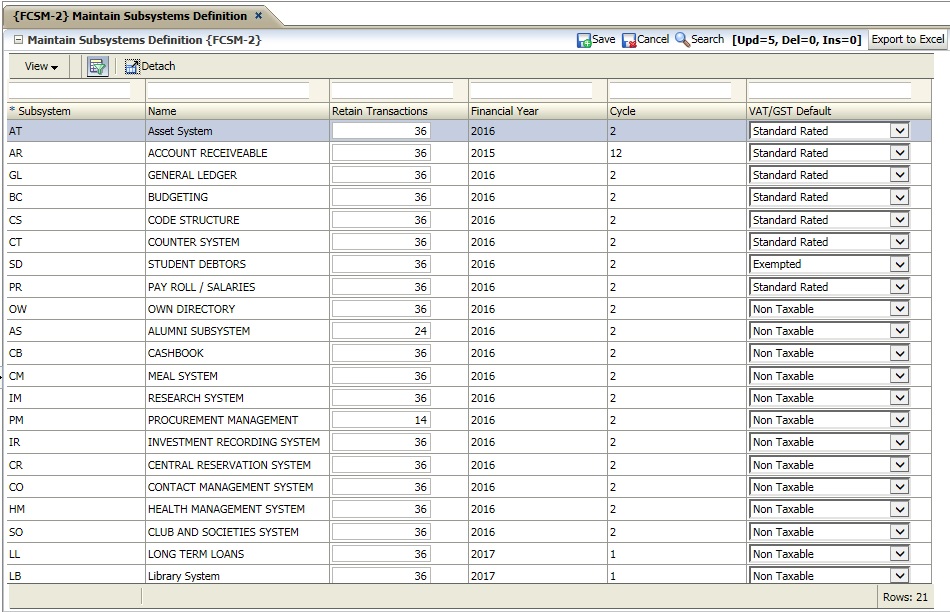 |
| Field | Type & Length |
Description |
|---|---|---|
| Code | A2 | Subsystem codes are system defined
and no records can be
inserted or deleted. |
| Name | A30 | Displays the subsystem name. |
| Retain Transactions | N2 | Indicate in cycles how long transactions for the
specific subsystem
should be retained. A maximum of 36 cycles and minimum of 14 cycles are
allowed. The user should note that the minimum cycles for the Payroll
System is 24 cycles. If less than 24 cycles are specified, for the Payroll, the subsystem will automatically default to 24 cycles. |
| Financial Year/Cycle | N4/N2 | The current financial year and cycle of
the subsystem. This fields are not updateable. The financial
year
and cycle is updated when Period end and /or Post to
General
Ledger with the parameter increment cycle are
executed. |
| VAT / GST Default | A1 | The system allows for a tax default on sub system level
for
VAT/GST purposes. Should all the activities in a subsystem
relate
to a specific type of supply, for example, under SA VAT legislation,
supply of educational service are exempted from VAT, setting
the
default to E- Exempted, the supply indicator of Exempted and a rate of
0.00 will default when the user process
any transaction in
the subsystem. Institutions should be cautious when setting the default to non-taxable where the entity is registered for tax. It is suggested that Institutions seek advice form a qualified tax practitioner in this regard. The following tax defaults are available, Standard Rate, Exempted, Zero Rated, Non-taxable and Cost Centre. Valid values are: S - Standard Rated E - Exempted Z - Zero Rated N - Non-taxable C- Cost Centre default - The vat code as defined on the cost centre will be used as a default. |
|
|
Processing
Rules
|
|
|---|---|
|
Open Cycles |
For
reporting and reconciliation purposes transaction are grouped together
based on the financial period to which the transaction relates. Open
cycle’s supports the processing of transactions into the
current
and future financial cycles deriving transactions cycle’s
according to the document or reference date. This is particularly
useful at and after month ends where all transactions relating to the
old month have not yet been processed and there is a need to process
the new month transactions. The Open Cycle concept is driven by the transaction type of a transaction where the Open Cycle indicator on the transaction type determines if the logic is applied. If the “Use Open Cycle” sod is set to yes and the indicator on the transaction type definition is set to yes the cycle is derived from the document / reference date and provided that the derived cycle is equal or greater than the system cycle for the subsystem {FCSM-2} the derived cycle is used as the transaction cycle. If the derived cycle is less than the system cycle for the subsystem, the system cycle is used as the transaction cycle. Once the system cycle has been incremented the old cycle is closed and the current and future cycle in the year is open for transaction processing provided that open cycles are used. |
| New Install | When a new client is installed the fields year, cycle, retention period and tax default are null and should be updated to the appropriate values. |
| Date | System Version | By Whom | Job | Description |
|---|---|---|---|---|
| 27-Sep-2006 | v01.0.0.0 | Amanda Nell | t133486 | New manual format. |
| 02-Feb-2009 | v01.0.0.1 | Ernie van den Berg | t155140 | Review the manual. |
| 24-Nov-2011 | v02.0.0.0 | Marchand Hildebrand | t178236 | Apply to Int 2 |
| 25-May-2012 | v02.0.0.1 | Marchand Hildebrand | t182907 | Remove number of approvals from the manual |
| 16-Oct-2014 | v03.0.0.0 | Marchand Hildebrand | t195346 | Add Open Cycles |
| 23-Feb-2016 |
v04.0.0.0 |
Matete Masite |
t209187 |
Updated the image
and changed |